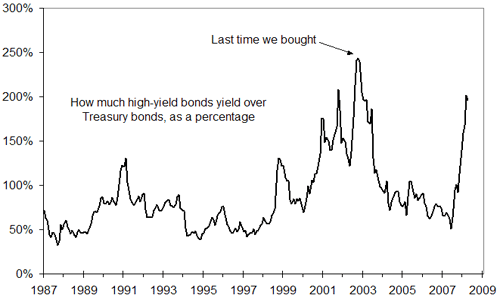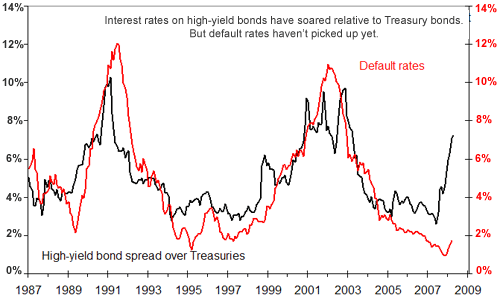| Home | About Us | Resources | Archive | Free Reports | Market Window |
Is it Time to Buy High-Yield Bonds Again?By
Tuesday, May 13, 2008
n late 2002, I recommended buying a way to play high-yield bonds, for the first time ever, in my newsletter, True Wealth. Our timing was excellent... We bought the Debt Strategies Fund (DSU), which held a basket of high-yield bonds and was paying a double-digit interest rate. From late 2002 to late 2003, trough to peak, the fund nearly doubled. In boring bonds! We're seeing a similar setup right now... So the question is, should we be buying high-yield bonds now? Despite the big move back in 2003, bond funds aren't supposed to double in a year. They're not designed to... The basics of a bond are usually something like this: You invest $1,000 in a bond paying 5% interest. You receive your 5% a year in interest. Then in five years' time, you get your $1,000 back. No possibility of triple-digit returns there. But when we bought our high-yield bonds, some of those $1,000 bonds were selling for only $600. When the prices went up from $600 to $1,000, we made great money – plus the interest too! Since late 2003, high-yield bonds haven't done all that well. DSU is only up about 16% in four years or so. But now, DSU is paying more than 11% in interest. Is DSU a buy once again? Let's see... The last time we bought high-yield bonds, we were in the midst of the dot-com bust. Companies were going under. And investors were fleeing anything risky. Prices fell on high-yield bonds, as people sold. So bond yields shot up. That's when we swooped in and bought. We're seeing a similar situation now... Investors have fled anything risky. And bond yields have shot up. Take a look:
This chart shows how much more interest you can earn from high-yield bonds than from U.S. Treasuries. You see, Treasuries are considered one of the safest investments out there... but you don't get a big percentage yield. Right now, they're paying less than 4%. When high-yield bonds are yielding the same as Treasuries, investors don't have much incentive to take on the extra risk to get a slightly higher yield. And when times get turbulent, like now, investors flee high-yield bonds... which pushes the yield up. That gets me interested. One thing is different this time though... Take a look at the next chart:
Historically, high yields on risky bonds have coincided with high default rates. But default rates on bonds have not risen yet. So one of two things will happen... Either the default rate will soar, or – if default rates stay the same – high-yield bond prices will soar, and you'll make a mint in shares like DSU, starting now. If you're really bold, and really optimistic about the economy, you could buy high-yield bonds now, and possibly make a lot of money. But if you're not so bold, like me, and you believe that things aren't different this time – that default rates will climb in this recession as they have in the last two – then you'll wait. If you look closely at the chart, you'll notice we've seen something similar to this two times before... In 1989, default rates were low, but interest rates started to spike. Default rates started to rise a bit late, but they didn't stop rising until they hit double digits. And in 1998, the same thing happened, and default rates again started rising and didn't stop until they hit double digits. I expect defaults will rise – which would hurt anyone invested in a bond fund now. But will defaults get to double-digits? I don't know. The double-digit yields on funds like DSU are incredibly enticing. But when it comes to high-yield bonds, I'm not willing to bite, yet. Good investing, Steve
Further Reading:
More Income for You, More Often Market NotesAN EXTRAORDINARY TURNAROUND IN TRANSPORTS Another vote for "things aren't so bad": the extraordinary turnaround in transportation stocks. More than 120 years ago, Charles Dow created the most widely followed gauge of American shipping, rail, and trucking stocks. He called it the Dow Transportation Average. Dow reasoned if the industrial producers of goods and the transporters of goods were both doing well, the stock market was in "bullish mode" and should be traded from the long side. As we covered in this column, transportation shares took a beating last fall when investors realized the American economy was due for a slowdown. The transports fell 22% and reached a two-year low in January. In just the last three months, however, this index has rallied to approach last year's high. The U.S. still has big problems to work through before another economic boom can take place. But the strength in the transports is a clear signal the U.S. is doing much better than most give it credit for. |
Recent Articles
|



